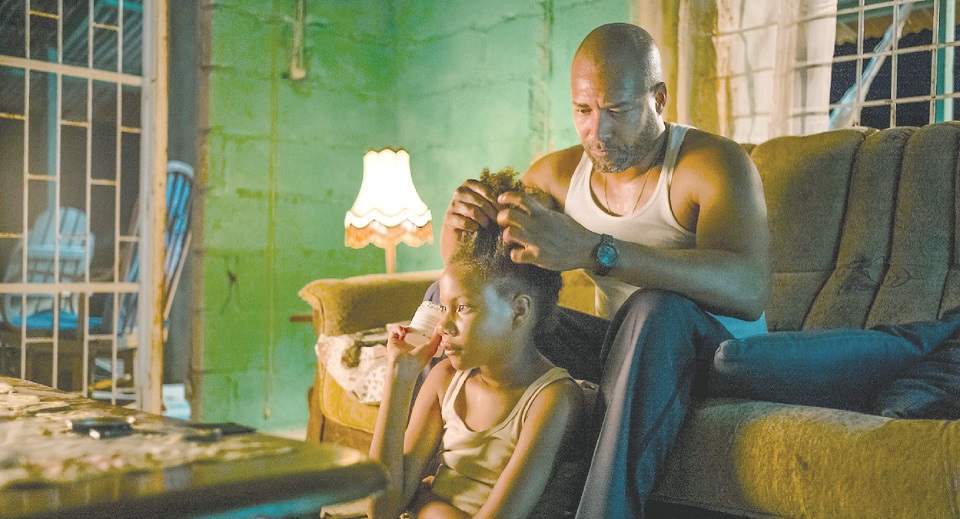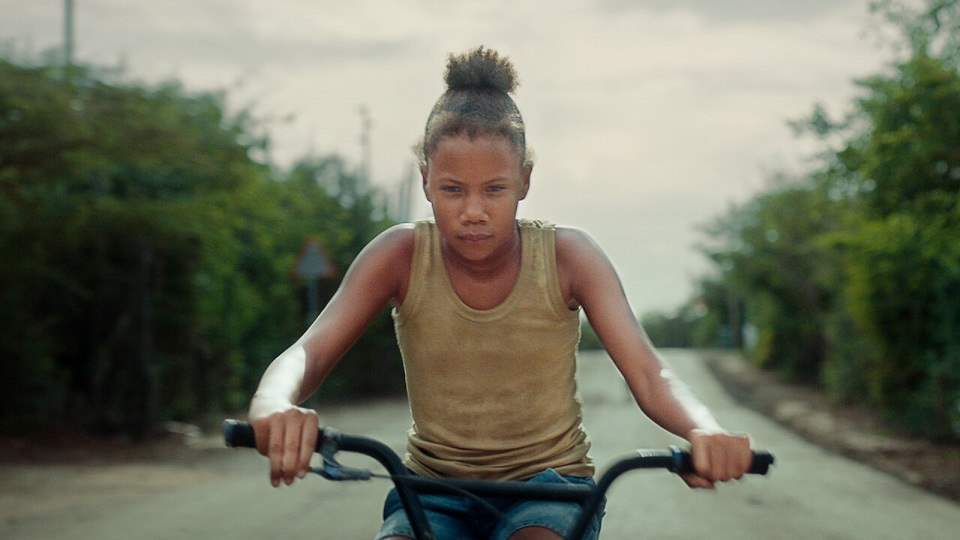Buladó, A film recently screened at the 33rd
European Film Festival in Jordan, represents two worldviews at odds with each
other through a small family in the countryside of Curaçao. Kenza is an
eleven-year-old girl who lives with her father, Ouira, and grandfather Weljo.
The wayward child is caught between two worlds, that of rationality and that of
mysticism.
اضافة اعلان
In his film, director Eché Janga follows a
refreshingly nontraditional heroine, the unsmiling, tough, and stubborn
11-year-old girl Kenza played by Tiara Richards, who gets in trouble at school
and doesn’t seem to have friends.
 Kenza sitting as her father
does her hair. (Photo: IMDb)
Kenza sitting as her father
does her hair. (Photo: IMDb)
Kenza struggles with her widower father
Ouira, played by Everon Jackson Hooi, a local policeman who wants her to follow
the rules, and finds herself drawn into the spiritual world of her grandfather,
Weljo, played by Felix de Rooy, who still practices the rites passed down from
the island’s slave ancestors.
Buladó is set in Bandabou, the wild west of
Curaçao – the birth island of the father of filmmaker Eché Janga – and is not
primarily about Weljo or Ouira but about Kenza. Set as a coming-of-age film,
Kenza encounters a void she had not yet known.
There is a conflict at home between her
orderly father, a highly rational police officer, and her grandfather, who is
spiritual and feels particularly close to magic and its Caribbean roots.
Kenza tries to find a way to navigate these two extremes, exposing the
differences between Dutch and Antillean culture
Buladó represents these two conflicting
elements in the film using the beautiful form of magical realism to make this
inner struggle tangible.
Finding
Comfort
Weljo's mind is deteriorating. He is
increasingly withdrawn into his own world, acting aggressively towards
strangers and rarely doing anything other than drink and speak a confusing
language amid his collection of scrap metal.
According to Ouira, it is time for the man
with dementia to be admitted to a nursing home, where he can spend his last
days in peace.
Weljo, on the other hand, feels the nearness
of death and seeks contact with the spirits of his ancestors, who will show him
the way to the realm of the dead. Then when the time is right, he will travel
on the wings of the wind to be completely free again.
This scenario leads to the central discourse
of the film. Where police officer Ouira presents observable facts, social
rules, and demarcations. Yet, at the same time, Weljo believes that life and
death, spirituality and reality constantly intertwine. Where Ouira answers to
the voice of reason, Weljo listens to the voice of the wind.
Accompanied by Kenza’s age comes the
difficulties of puberty. Kenza, curious about her mother, who passed away when
she was born, finds no answers from her father.
As Kenza navigates her first period, she girl
never knew her mother. This lack of a maternal figure becomes increasingly
difficult for her to navigate, and her father, unaware of how to assist, offers
no support.
At school, Kenza is trouble. She skips school
quite a lot and she is also often involved in quarrels at school.
While she’s seemingly uninterested in school,
her grandfather fascinates her. He constantly has a bottle of alcohol in his
hand but is full of beautiful stories about their ancestors and ghosts.
The
power of wind
The film opens with a beautifully poetic
account of the wind, with shots of clouds moving at great speed over the
island. On the island, the wind is an ever-present and fascinating element.
The air currents take on an extra mystical charge
because it also becomes a means of communicating with ancestral spirits, and as
the wind changes, so does the spiritual meaning.
The beautiful colors – especially green and
blue – splash off the screen, yet it is far from joyful. Instead, the film emphasizes
the dichotomy between physical beauty and emotional significance, for it
navigates beautiful scenery with heavy emotions.
The film balances on the ethereal and dreamy,
partly due to the spiritual grandfather. The struggle that Kenza has to fight to
find her way is accurately depicted for ac coming of age story. She learns from
both and finds her way.
Sometimes the story is too quick and easy in
its choices, but wit makes a lot of sense ithin the 86 minutes of the film.
The sadness is evident. The question of missing something you’ve never
had is questioned consistently, and death is a recurring theme. Incidentally,
the music and the beautiful nature are also worth mentioning. The latter is
emphasized in the impressive way of filming
The acting also elevated the experience,
especially Everon Jackson Hooi’s performance, which you may also know as Bing
in Good Times Bad Times.
The film takes us back to the age-old
question that has been told raised for a long time, the heart versus the head.
The story of Kenza shows us how she learns to
deal with her grief and navigates both reason and magic, and finds her journey
between the two.
The magical realism and poetry present in the
film are rare in Dutch cinema and a welcome enrichment in the film world.
The
actors and the setting
The clashing opposites of reason and logic
versus mystical traditions of the island are the common thread in the film. But
the stories and myths are also important.
The film is personal to Janga due to its
familial relation, but it was also a challenge for Jackson Hooi because it
takes place on his native island.
 Kenza, the unsmiling,
tough, and stubborn 11-year-old girl protagonist. (Photo: IMDb)
Kenza, the unsmiling,
tough, and stubborn 11-year-old girl protagonist. (Photo: IMDb)
The young Tiara Richards as Kenza is a golden
find. With her brutal side and fearlessness, but also her vulnerable side, she
acts wonderfully. Finally, Felix de Rooy, an artist, and director, is masterful
as the mystical and philosophical grandfather.
Eché Janga graduated from the Dutch Film
Academy in 2010 and launched his debut with Helium (2014), a drama with
mystical and philosophical elements. The film won two Golden Calves.
Janga is experienced in portraying more
prominent themes through specific, well-thought-out scenarios that present us
with this mystical reality in Buladó, similar to his work in his short film Mo
(2010) and his feature film debut Helium (2014).
Buladó is his second major feature film. For
a long time, he was unsure about filming and telling this story on Curaçao. His
parents may come from Curaçao and the Antilles, but he is not from there
himself. But he was embraced on the island by the locals.
With Buladó, Janga is one of the few Dutch
filmmakers to situate a story in a former colony and to reflect on the past
through the present time.
This makes his coming-of-age story about a
Curaçaoan girl a reasonably unique project. A few years ago, there was a film
adaptation of “Double Play,” the famous book by Frank Martinus Arion, but it
was directed by an American, and it was in English.
He and Esther Duysker co-wrote Buladó. It is
a story about holding on and letting go and about three generations that need
each other to take the next step.
Read more Entertainment

